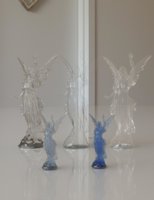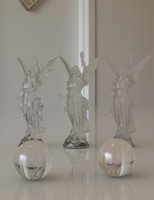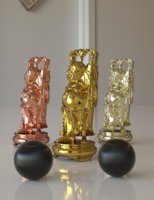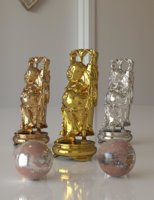AWE Surface 1.0
AWE Surface is a new, robust, highly optimized, physically plausible shader for DAZ Studio and 3Delight employing physically based rendering (PBR) metalness / roughness workflow. Using a primarily uber shader approach, it can be used to render materials such as dielectrics, glass and metal.
Features Highlight
DAZ - Google Drive
Installation instructions
The aweSurface.zip contains a readme for the shader and some basic shader presets that will apply AWE Surface to the existing materials. The contents of aweSurface DS App Folder Files.zip are the compiled Renderman shader code (.sdl) and supporting DS scripts to be placed within your DAZ Studio application folder (ie Program Files/DAZ 3D/DAZ Studio 4/..." Mustakettu's render script files are also included in this archive.
There's a simple example scene to the Google drive folder with the DAZ Material Ball loaded and an environment sphere with OMKHPark applied. All the surfaces in the scene except for the environment sphere have AWE Surface applied.
More info can be found in the readme.






For best results, render with the included mustakettu's 3delight render script. It's also a good way to see if your installation is successful. You should be able to see these in the renderer settings.
AWE Surface is a new, robust, highly optimized, physically plausible shader for DAZ Studio and 3Delight employing physically based rendering (PBR) metalness / roughness workflow. Using a primarily uber shader approach, it can be used to render materials such as dielectrics, glass and metal.
Features Highlight
- Physically based BRDF (Oren Nayar for diffuse, Cook Torrance, Ashikhmin Shirley and GGX for specular).
- Micro facet energy loss compensation for the diffuse and transmission lobe.
- Transmission with Beer-Lambert based absorption.
- BRDF based importance sampling. Multiple importance sampling (MIS) with 3delight's path traced area light shaders such as the aweAreaPT shader.
- Explicit Russian Roulette for next event estimation and path termination.
- Raytraced subsurface scattering with forward/backward scattering via Henyey Greenstein phase function.
- Physically based Fresnel for both dielectric and metal materials. Unified index of refraction value for both reflection and transmission with dielectrics. An artist friendly metallic Fresnel based on Ole Gulbrandsen model using reflection color and edge tint to derive complex IOR.
- Physically based thin film interference (iridescence).
- Shader based, global illumination.
- Luminance based, Reinhard tone mapping with exposure, temperature and saturation controls.
- Toggle switches for each lobe.
- Diffuse Oren Nayar based translucency with support for bleed through shadows. Can use separate front/back side diffuse color and texture.
- Two specular/reflection lobes for the base, one specular/reflection lobe for coat.
- Anisotropic specular and reflection (only with Ashikhmin Shirley and GGX BRDF), with map-controllable direction.
- Glossy Fresnel with explicit roughness values, one for the base and one for the coat layer.
- Optimized opacity handling with user controllable thresholds.
- Imports most settings and values when converting materials from dsDefaultMaterial, HumanSurface Shader, UberSurface and UberSurface 2.
DAZ - Google Drive
Installation instructions
The aweSurface.zip contains a readme for the shader and some basic shader presets that will apply AWE Surface to the existing materials. The contents of aweSurface DS App Folder Files.zip are the compiled Renderman shader code (.sdl) and supporting DS scripts to be placed within your DAZ Studio application folder (ie Program Files/DAZ 3D/DAZ Studio 4/..." Mustakettu's render script files are also included in this archive.
There's a simple example scene to the Google drive folder with the DAZ Material Ball loaded and an environment sphere with OMKHPark applied. All the surfaces in the scene except for the environment sphere have AWE Surface applied.
More info can be found in the readme.






For best results, render with the included mustakettu's 3delight render script. It's also a good way to see if your installation is successful. You should be able to see these in the renderer settings.

